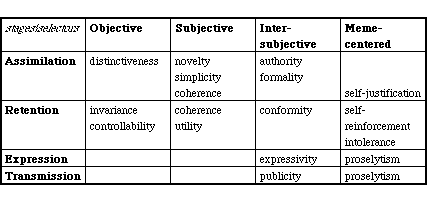|
Memetic Selection Criteria
during the different stages of their life-cycle, memes are subjected to objective, subjective intersubjective and meme-centered selection criteria
|
These are the criteria that determine the overall fitness of a meme,
whether it will maintain within an individual's memory and spread to other
individuals, or be eliminated. As meme spreading
depends on different objective, subjective and intersubjective mechanisms, the
criteria are sometimes contradictory. See the general selection criteria for knowledge for more details on individual criteria.
Objective Criteria
Objective criteria denote selection by phenomena or objects independent of the hosts and memes involved in the process. The distinctiveness criterion functions mainly during the assimilation stage. It states that phenomena that are distinct, detailed or contrasted are more likely to be noticed and understood, and therefore assimilated. The invariance and controllability criteria, on the other hand, apply mainly to the retention stage. According to the invariance criterion, phenomena that recur, independently of the way in which they are perceived, are more likely to be maintained in memory. Controllability notes that phenomena which react differentially to the subject's actions are also more likely to leave a permanent memory trace.
Subjective Criteria
Subjective criteria represent selection by the subject who assimilates the meme. The main criteria at the assimilation stage are novelty (facilitates assimilation by attracting the subject's attention) and simplicity (requires less processing for the meme to be understood). The criterion of coherence (connection, consistency and support between new perception and existing memory trace) facilitates the understanding and acceptance parts of the assimilation stage, since it represents the ease with which the new meme can "fit in" with the memory that is already there. It also facilitates the retention stage since memories that cohere are more easy to retrieve and use and are therefore less likely to be forgotten. The criterion of utility, like controllability, functions mainly at the retention stage, since useful memes are more likely to be effectively used and thus reinforced, although it will also help assimilation, by making it more worthwhile for the host to do the effort to assimilate.
Intersubjective Criteria
Intersubjective criteria represent selection through the interactions between different subjects. Group utility is an emergent criterion, that is implicit in all four stages: a memes that is useful to the group of all its hosts is more likely to survive because it helps the group itself to survive and grow, and thus to absorb other individuals. Authority functions mainly at the assimilation stage: memes from authoritative sources, i.e. hosts or vehicles that are held in high regard or considered to represent expertise in the domain, will be more easily noticed and accepted. Formality (i.e. precise, unambiguous expression) too helps assimilation, at least of the original memetic content of the expression. It will contribute basically to what Dawkins (1976) calls copying-fidelity. (On the other hand, informal expression, because it tends to be simpler, may facilitate assimilation, but of an idea different from the one initially expressed). Conformity, the reinforcement of the same meme by different hosts belonging to the same group, will boost acceptance and retention (cf. Boyd & Richerson, 1985). Expressivity, the ease with which the meme can be expressed in an intersubjective medium, will obviously contribute to the expression stage. Publicity, finally, the effort put by the host(s) into the broad distribution of the message, will maximize transmission.
Meme-centered Criteria
Finally, the meme-centered criteria represent selection on the level of the meme itself. They depend only on the internal structure of the meme, not on its "fit" to external selectors, such as subjects, objects, or groups. These criteria will typically select for "selfish" (cf. Heylighen, 1992) or "parasitic" (cf. Cullen, 1998) memes, whose only goal is to spread themselves, "infecting" a maximum of hosts without regard for their hosts' well-being. This does not imply that the same meme cannot satisfy both selfish and non-selfish criteria. Religions often have this mixture of parasitic and beneficial traits (cf. Cullen, 1998)
Self-justification, the degree to which the components of a meme mutually support each other, will facilitate understanding and acceptance. Self-reinforcement, the degree to which the meme stimulates its host to rehearse itself, e.g. by repetition, meditation, prayer, etc., will strengthen retention. Intolerance, the degree to which a meme excludes rival memes from being assimilated or retained, will also help the meme to retain a stable position in memory. Proselytism, the degree to which the meme urges its host to maximally spread the meme to other hosts, will increase the rates of expression and transmission.
 Table: a summary of the main selection criteria for memes, classified according to the stage during which they are most active, and the system responsible for the selection.
References:
- Boyd R. & Richerson P.J. (1985): Culture and the Evolutionary Process, (Chicago University Press, Chicago).
- Cullen B. (1998): "Parasite Ecology and the Evolution of Religion", in: Heylighen F. (ed.) (1998): The Evolution of Complexity (Kluwer Academic,
Dordrecht)
- Dawkins R. (1976): The Selfish Gene, (Oxford University Press, New York).
- Heylighen F. (1992) : "
 Selfish
Memes and the Evolution of Cooperation", Selfish
Memes and the Evolution of Cooperation", Journal of Ideas , Vol.
2, #4, pp 77-84. Journal of Ideas , Vol.
2, #4, pp 77-84.
- Heylighen F. (1998): "What makes a meme successful? Selection criteria
for cultural evolution", in: Proc. 16th Int. Congress on Cybernetics (Association Internat. de Cybernetique, Namur), p. 423-418.
- Heylighen F. (1997):"Objective, subjective and intersubjective selectors of knowledge", Evolution and Cognition 3:1, p. 63-67.
Copyright© 2001 Principia Cybernetica -
Referencing this page
|
|
Author
F. Heylighen,
Date
Nov 23, 2001 (modified)
Aug 18, 1994 (created)
|
|

